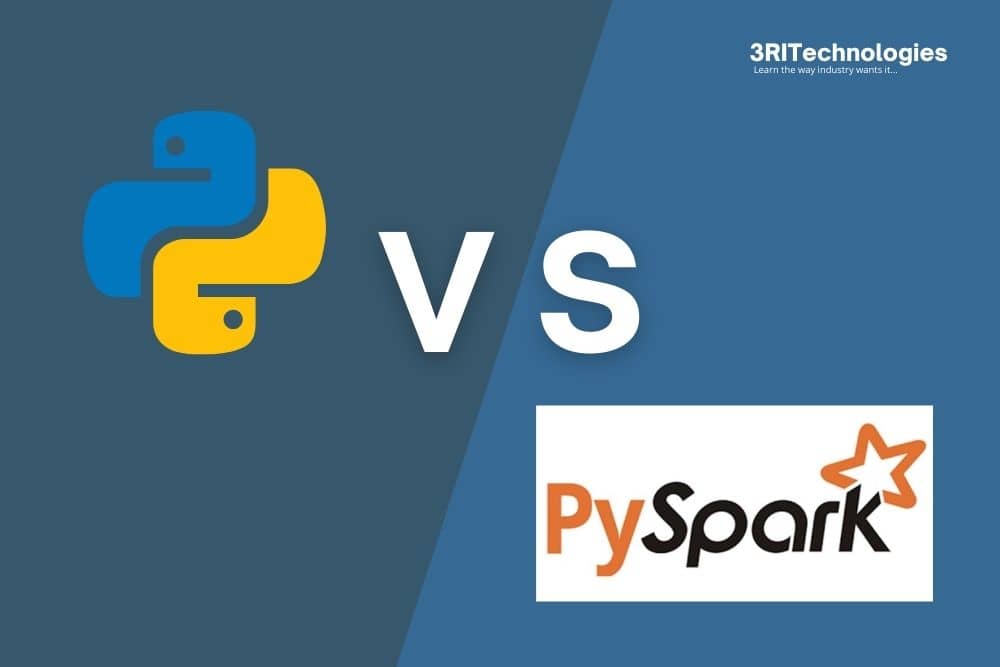Difference Between Python and PySpark
PySpark is a Python-based API for utilizing the Spark framework in combination with Python. As is frequently said, Spark is a Big Data computational engine, whereas Python is a programming language. This post will discuss the difference between Python and pyspark.
What is Python?
Python is quickly gaining prominence as the language of choice of a data scientist. Python can help you utilize your data abilities and will undoubtedly propel you forward. Python is an extremely powerful language that is yet quite easy to learn and use. Python is not simply used in data science; it is also used in various other fields such as machine learning and artificial intelligence.
Python is a powerful language with many enticing characteristics such as ease of learning, simplified syntax, improved readability, and the list goes on. It’s an interpreter-based, functional, procedural, and object-oriented computer programming language. Python’s best characteristic is that it is both object-oriented and functional, allowing programmers to think of code as both data and functionality. In other words, any programmer would contemplate resolving a problem using a data structure and an execution of an operation. The object-oriented approach is concerned with a data structure (objects), whereas the functional approach concerns behavior management.

Why Python?
• Python is a cross-platform programming language.
• Python offers a straightforward, English-like syntax.
• The syntax of Python allows developers to write shorter programs than some other programming languages.
• Python is an interpreter-based language, such that it may execute instantly once code is written. The prototype may therefore be done in a relatively short time.
• Python may address with one of three methods: linear, object-oriented, or functional.
Want to Upskill to get ahead in your career? Check out the Python Training in Pune.

Want Free Career Counseling?
Just fill in your details, and one of our expert will call you !
What are the advantages of using Python?
Multipurpose, simple to use, and quick to create
Python places a premium on the brevity of code. The language is flexible, well-structured, simple to use and learn, readable, and understandable.
Python’s flexibility makes exploratory data analysis simple – in other words, hunting for needles in a haystack when you’re unsure what the needle is. Python enables you to exploit the advantages of many programming paradigms. It is object-oriented but actively incorporates aspects of functional programming. Learn at 3RI Technologies.
With a thriving community, it’s open-source.
Python is completely free, and you can start creating code in minutes. Python is a painless language to program.
Additionally, the Python programming community is one of the greatest globally – it is highly active and big. Some of the world’s brightest brains in information technology contribute to the language’s development and support forums.
Excellent for prototypes – With less code, you can do more.
Python, as previously said, is a simple language to learn and a lightning-fast development environment. Python allows you to accomplish more with less code, translating into far faster prototyping and testing concepts than other languages.
Productivity
Additionally, Python is a productive programming language. Its integration and control features enable programs to run more efficiently. Python is more productive than Java than other languages due to its dynamic typing and concise syntax.
need to enquire for course:
Connect with us
Python’s primary drawbacks
need to enquire for course:
Connect with us
Programmers with experience always advocate using the appropriate tools for the job. It’s helpful to understand both the pros and downsides of Python.
Limitations on speed
Python is an interpreted language. Thus it might be slower than specific other popular programming languages. However, if speed is not your primary concern, Python will suffice.
Threading-related issues
Due to the Global Interpreter Lock, threading in Python is not optimal (GIL). GIL is nothing more than a mutex that imposes a single-thread restriction on execution. As a result, multithreaded CPU-bound algorithms may run slower than single-threaded programs, according to Mateusz Opala, Netguru’s Machine Learning Lead. Fortunately, this issue does have a remedy. – Instead of multithreaded applications, we must develop multiprocessing programs. That is frequently the case when we handle data.
Not adapted for mobile use
Python is not a native language for mobile environments, and some programmers regard it as a poor choice for mobile computing. Python is not an official programming language supported by Android or iOS.
Consumption of memory
Bear in mind that Python consumes a lot of RAM. It may not be the choice for jobs that require a large amount of memory. It might be troublesome if there are a large number of active items in RAM.
Join our Full Stack Course in Pune today and gain in-depth knowledge of Python
What exactly is PySpark?
PySpark is a Python Spark API developed by the Apache Spark group to facilitate Python with Spark. PySpark enables easy integration and manipulation of RDDs in the Python programming language as well. Numerous aspects contribute to PySpark’s outstanding reputation as a framework for working with massive datasets. Data Engineers are increasingly using this tool to do computations on huge datasets or to evaluate them.
PySpark’s Critical Features
• Real-time computations: The PySpark framework is known for its reduced latency due to its in-memory processing.
• Excellent cache and disk persistence: This framework features excellent cache and disk persistence.
• Fast processing: The PySpark framework processes large amounts of data much quicker than other conventional frameworks.
• Python is well-suited for dealing with RDDs since it is dynamically typed.

Do you want to book a FREE Demo Session?
What are the advantages of using PySpark?
Then there are the advantages of utilizing PySpark. Let us discuss them in depth in Spark’s in-memory computing: It helps you enhance the processing speed using in-memory processing. And the greatest part is that the data is cached so that you don’t get data from the disk every time the time is saved. For the unknown, PySpark includes a DAG execution engine, which facilitates the calculation and acyclic flow of data, eventually leading to fast performance.
• Swift Processing: When using PySpark, you will probably obtain approximately ten times quicker data processing performance on the disk and 100 times faster in the memory. It might accomplish by decreasing the number of read-write to disk.
• Natural dynamics: Being dynamic helps you create a parallel application because Spark has 80 high-level operators.
• Fault tolerance in Spark: PySpark enables the use of Spark abstraction-RDD for fault tolerance. The programming language is designed to address the malfunction of any node in the cluster, therefore reducing data loss to zero.
• Real-Time Stream Processing: PySpark is known for real-time stream processing and far better than any other language. Earlier with Hadoop MapReduce, the difficulty was that the data present could manage, but not in real-time. However, this difficulty is greatly minimized using PySpark Streaming.
When is PySpark best used?
The distributed processing capabilities of PySpark are used by data scientists and other Data Analyst professions. And with PySpark, the best thing is that the workflow is unbelievably straightforward as never before. Using PySpark, data scientists in Python may create an analytical application, aggregate and manipulate data, and then provide the aggregated data. There is no argument that PySpark would be utilized in the phases of development and assessment. However, when producing a heat map, things becomes complicated to demonstrate how much the model predicted people’s preferences.
Enroll for Python Web Development Course and learn the Python Skills from Industry Experts
PySpark running
PySpark can dramatically speed up analyzes by allowing local and remote data transformation activities to be easily combined while retaining computer cost control. The language also allows data scientists to avoid vast sampling numbers of data. PySpark is something to consider for activities like constructing a recommendation system or training a machine-learning system. It is also vital for you to benefit from distributed processing, making it easy to add new data kinds to current data sets and integrate share pricing with meteorological data.
PySpark advantages
• Easy to write
We may claim that for basic issues, it is quite easy to develop parallel programming.
• The framework manages mistakes.
While synchronization points and faults are concerned, the framework can easily handle them.
• Algorithms
Many of the useful algorithms in Spark have already been implemented.
• Libraries
Compared with Scala, Python is far superior in the libraries provided. Since there are so many libraries, most of the R-related data science components are translated to Python. Well, in the case of Scala, this does not happen.
• Good local tools
There are no proper visualization tools for Scala, although there are nice local tools in Python.
• Curve of Learning
In Python, the learning curve is shorter than in Scala.
• Facility of usage
Again, Python is easier to use compared to Scala. Check out Python Training in Noida.
PySpark Disadvantages
• It’s hard to express
While expressing an issue in MapReduce way, it’s hard occasionally.
• Under-efficient
Compared with other programming paradigms, pythons are less efficient. For example, like MPI, when a lot of communication is required.
• slow
In principle, Python’s performance is slow compared to Scala for Spark Jobs. About ten times slower. That indicates that Python is slower than Scala if we want to conduct extensive processing.

Meet the industry person, to clear your doubts !
• Immature
In Spark 1.2, Python supports Spark Streaming but is not yet as sophisticated as Scala. So, if we require streaming, we must switch to Scala.
• Spark internal functionality cannot use
Since the entire Spark is built in Scala, thus we must work with Scala if it’s our project that we want to or must modify from the core Spark working; we cannot use Python.
• Machine Learning Spam Detector Project
However, we can comprehend it with an example, however, note that we scan a new RDD with Scala in the Core Spark but do not build it with Python.
Conclusion
Apache Spark is a cluster open-source computing platform centered on performance, ease of use, and streaming analysis, whilst Python is a high-programs language for all purposes. It contains a big library collection and is mainly used to learn machines and stream analytics in real-time.
Looking forward to becoming a Python Developer? Then get certified with Python Online Training
Python Training Offered In Different Locations are
